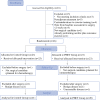Effect of Preoperative Home-Based Exercise Training on Quality of Life After Lung Cancer Surgery: A Multicenter Randomized Controlled Trial
- PMID: 37934383
- PMCID: PMC10761542
- DOI: 10.1245/s10434-023-14503-2
Effect of Preoperative Home-Based Exercise Training on Quality of Life After Lung Cancer Surgery: A Multicenter Randomized Controlled Trial
Abstract
Background: Preoperative exercise training is recommended for improvement of clinical outcomes after lung cancer (LC) surgery. However, its effectiveness in preventing postoperative decline in quality of life (QoL) remains unknown. This study investigated the effect of preoperative home-based exercise training (PHET) on QoL after LC surgery.
Methods: Patients awaiting LC resection were randomized to PHET or a control group (CG). The PHET program combined aerobic and resistance exercise, with weekly telephone supervision. Primary outcome was QoL-assessed with the European Organization for Research and Treatment of Cancer (EORTC) Quality of Life Questionnaire C30 (QLQ-C30) at baseline, before surgery, and 1 month after surgery. The secondary outcomes were hospital length of stay and physical performance. The main analysis included a factorial repeated-measures analysis of variance. Additionally, the proportion of patients experiencing clinical deterioration from baseline to post-surgery was assessed.
Results: The study included 41 patients (68.1 ± 9.3 years; 68.3% male) in the intention-to-treat analysis (20 PHET patients, 21 CG patients). A significant group × time interaction was observed for global QoL (p = 0.004). Between-group differences in global QoL were statistically and clinically significant before surgery (mean difference [MD], 13.5 points; 95% confidence interval [CI], 2.4-24.6; p = 0.019) and after surgery (MD, 12.4 points; 95% CI, 1.3-23.4; p = 0.029), favoring PHET. Clinical deterioration of global QoL was reported by 71.4% of the CG patients compared with 30 % of the PHET patients (p = 0.003). Between-group differences in favor of PHET were found in pain and appetite loss as well as in physical, emotional and role functions after surgery (p < 0.05). Compared with CG, PHET was superior in improving preoperative five-times sit-to-stand and postoperative exercise capacity (p < 0.05). No between-group differences in other secondary outcomes were observed.
Conclusion: The study showed that PHET can effectively prevent the decline in QoL after LC surgery.
Keywords: Home-based exercise training; Lung cancer; Prehabilitation; Quality of life; Surgical resection.
© 2023. The Author(s).
Conflict of interest statement
There are no conflicts of interest.
Figures




Comment in
-
ASO Author Reflections: Impact of a Preoperative Home-Based Exercise Program on Quality of Life After Lung Cancer Resection.Ann Surg Oncol. 2024 Feb;31(2):897-898. doi: 10.1245/s10434-023-14620-y. Epub 2023 Nov 19. Ann Surg Oncol. 2024. PMID: 37980706 No abstract available.
References
Publication types
MeSH terms
Grants and funding
LinkOut - more resources
Full Text Sources
Medical

